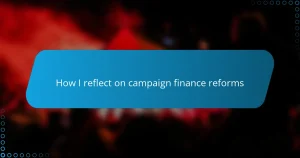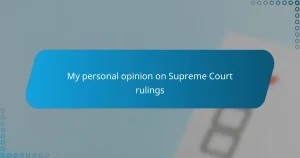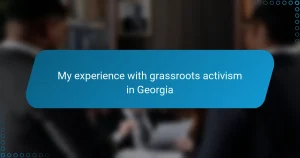Key takeaways
- Successful voter turnout strategies combine personal storytelling with community engagement to foster a sense of responsibility and urgency.
- Accessibility and trust in the political system significantly influence voter turnout; logistical barriers can deter participation while skepticism can lead to apathy.
- Authenticity, scalability, and adaptability are crucial criteria for evaluating the effectiveness of voter outreach strategies.
- Effective communication focusing on emotional connection can enhance voter engagement, with community leaders playing a pivotal role in encouraging participation.
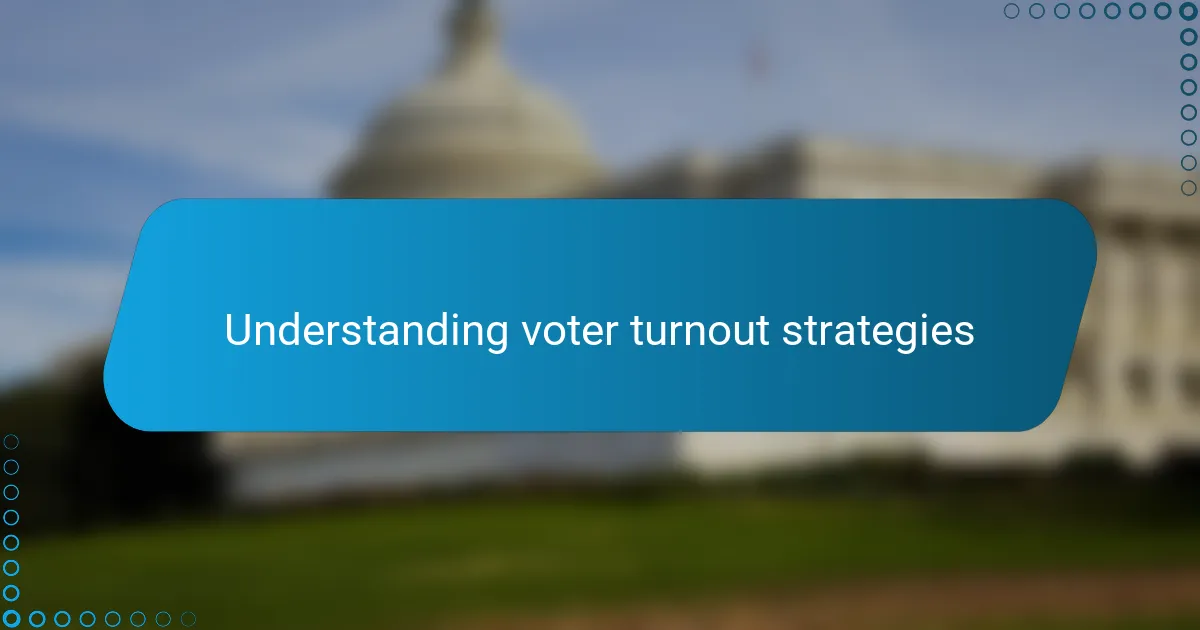
Understanding voter turnout strategies
When I first started analyzing voter turnout strategies, I was struck by how diverse the approaches can be—some focus on data analytics, while others lean heavily on grassroots mobilization. It made me wonder: what truly moves someone to leave their couch and cast a ballot? From my experience, understanding the emotional triggers behind voting decisions is just as critical as knowing the practical methods.
One thing I’ve noticed is that successful strategies often tap into personal stories and community ties, creating a sense of responsibility and urgency. Have you ever thought about how a simple conversation with a neighbor can ignite a commitment to vote? This interpersonal connection, I feel, is often underestimated but immensely powerful in driving turnout.
Delving deeper, I’ve realized that timing and messaging also play a huge role. A strategy that works brilliantly in one election cycle may fall flat in another if it doesn’t resonate with the current political climate or voter sentiments. This variability makes assessing these strategies both challenging and fascinating from my perspective.
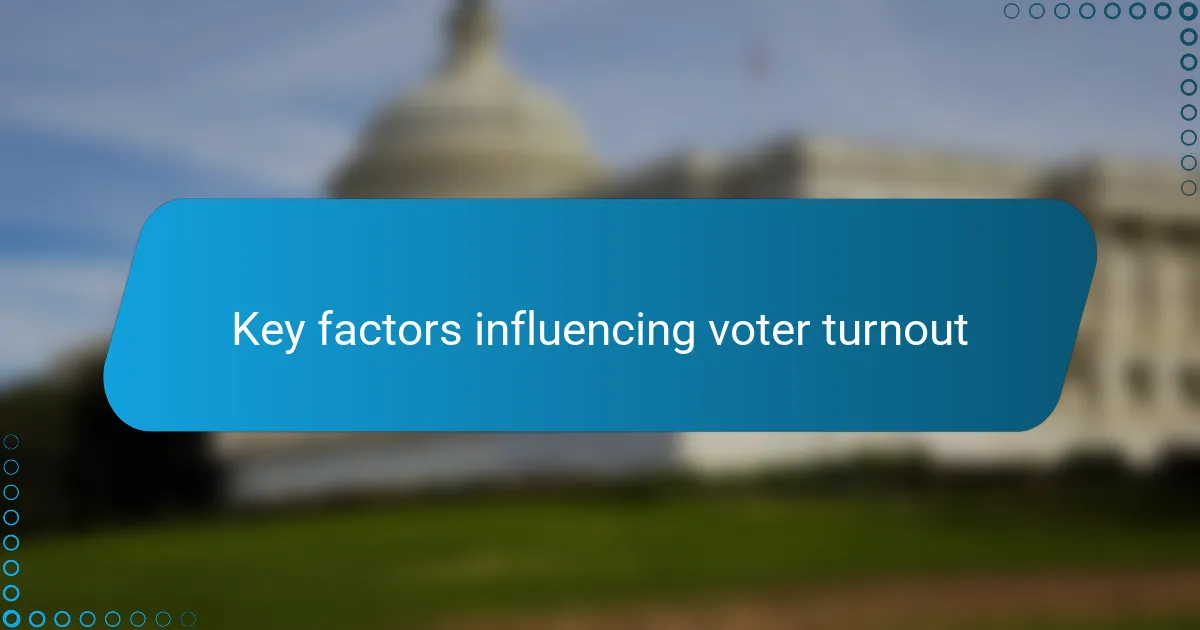
Key factors influencing voter turnout
What really stands out to me when considering key factors influencing voter turnout is the role of accessibility. When polling places are hard to reach or registration processes are complicated, many potential voters feel discouraged before they even begin. I remember talking to a friend who missed voting simply because the only nearby location had ridiculously long lines—that sense of frustration sticks with you and often turns people away.
I also can’t help but think about how much trust in the political system shapes turnout. If people feel their voices won’t matter or that the system is rigged against them, motivation drops sharply. Have you noticed how skepticism can be contagious? It’s like once someone loses faith that their vote counts, it’s easy for apathy to set in, creating a ripple effect.
Finally, the energy and enthusiasm around an election can’t be overlooked. I’ve seen firsthand how a candidate or issue that sparks passion can pull in voters who might otherwise sit it out. It raises the question: what is it about certain campaigns that ignite this fire? From my experience, when people feel genuinely connected to the stakes, turnout often surges in ways that data alone can’t predict.
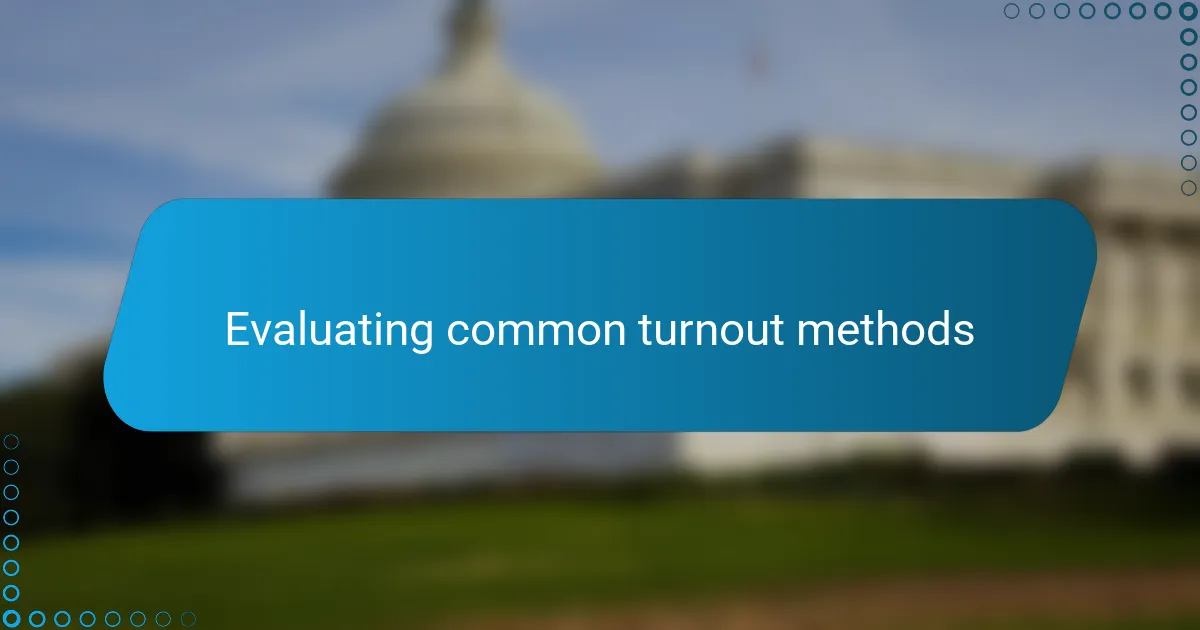
Evaluating common turnout methods
When I evaluate common turnout methods, door-to-door canvassing immediately comes to mind. From my experience, that personal touch can be a game-changer—it’s one thing to receive a flyer in the mail, but entirely another when someone looks you in the eye and talks about why voting matters. Have you ever had a neighbor knock on your door and convince you to get out and vote? That kind of connection feels genuine and hard to ignore.
Then there’s the use of text messages and phone banking. I’ve seen campaigns rely heavily on these modern tools, and while they can reach a lot of people quickly, I sometimes wonder if they lack the warmth that encourages real commitment. The volume can feel overwhelming, and honestly, I’ve noticed that not every message hits the right emotional chord, which makes me question their true effectiveness.
One more method I keep reflecting on is making voting easier through mail-in ballots or early voting options. I’ve talked to voters who genuinely appreciate these conveniences because they remove barriers like long lines or inflexible schedules. When logistical hurdles disappear, it seems voters are more willing to participate, reinforcing my belief that accessibility is a cornerstone of any successful turnout strategy.
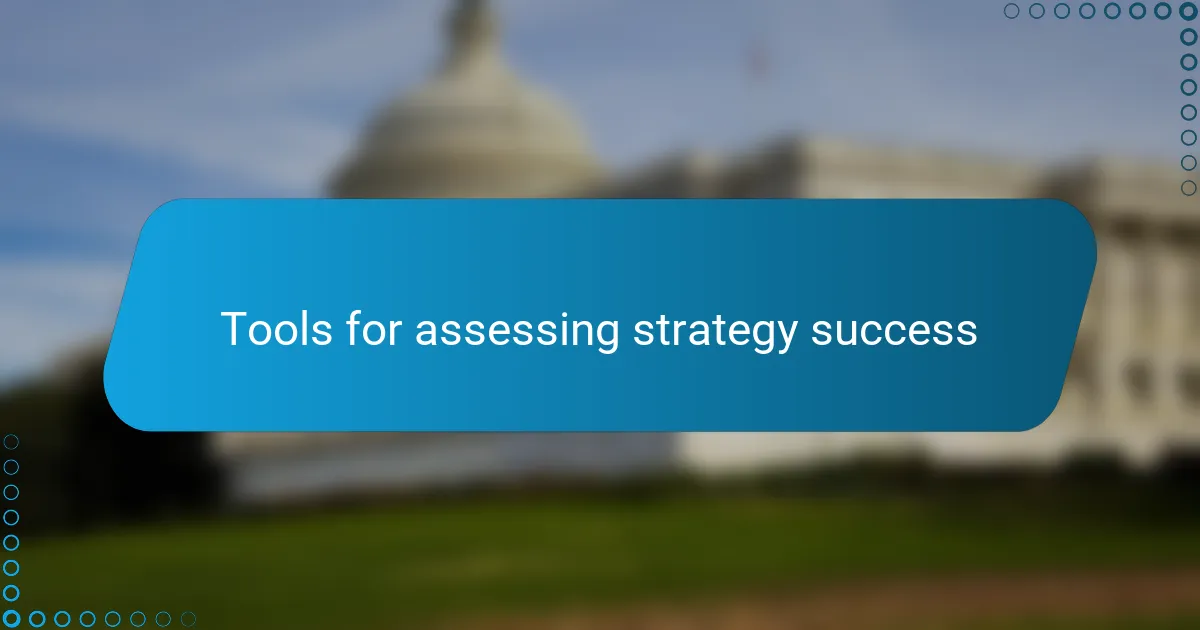
Tools for assessing strategy success
When I assess whether a voter turnout strategy is working, data analytics tools become my first stop. Tracking metrics like registration increases, early voting numbers, and demographic engagement gives me hard evidence of what’s moving the needle. Have you ever noticed how these numbers can tell a story that raw observations might miss?
But numbers alone don’t capture the full picture. I often rely on surveys and feedback loops from field organizers to gauge voter sentiment and enthusiasm—those emotional undercurrents that spreadsheets can’t reveal. It reminds me of a campaign I followed closely where grassroots volunteers’ stories painted a richer picture of impact than turnout stats alone.
Finally, social media monitoring tools have become surprisingly insightful for me. They help track conversations and identify whether key messages are resonating or falling flat in real-time. It makes me wonder: if you’re not listening to the digital buzz, how can you truly know if your strategy is connecting with voters where they actually communicate?
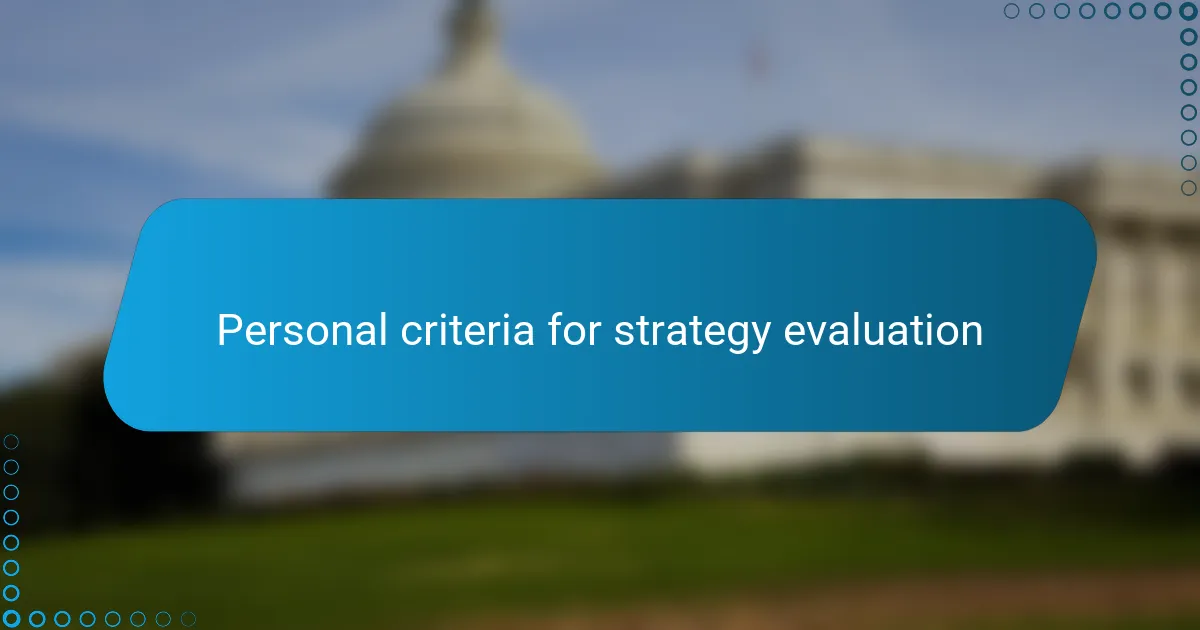
Personal criteria for strategy evaluation
When I evaluate a voter turnout strategy, one of my top criteria is authenticity. Does the approach feel genuine, or does it come across as rehearsed and impersonal? I remember attending a local canvassing event where volunteers really listened to people’s concerns instead of just reciting talking points—that authenticity made all the difference in motivating voters.
I also look closely at scalability. Can the strategy reach a broad audience without losing its personal touch? It’s tricky because what works in a small community might not translate effectively on a larger scale. Have you ever noticed how some campaigns feel more like a grassroots movement, while others seem too corporate and detached?
Finally, I consider adaptability. A strategy has to flex with changing circumstances, whether that’s political tension, voter demographics, or unexpected events. From my experience, the best turnout efforts aren’t rigid scripts but living plans that adjust based on ongoing feedback and results. Isn’t it fascinating how the ability to pivot can sometimes make or break the success of these initiatives?
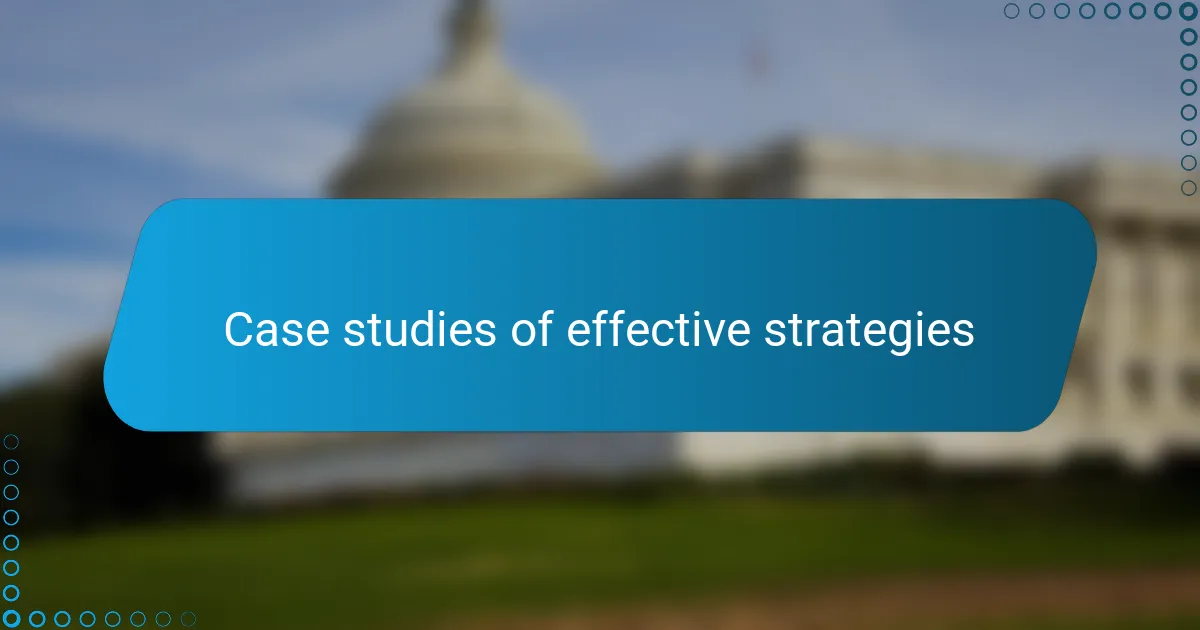
Case studies of effective strategies
One case study that really stayed with me involved a grassroots campaign in a midwestern city that combined door-to-door canvassing with neighborhood storytelling nights. I was struck by how sharing personal voting stories in a relaxed setting created a sense of collective purpose that no amount of flyers or social media posts could replicate. Have you ever experienced how hearing a friend’s voting journey can suddenly make you rethink your own sense of responsibility?
Another example I’ve analyzed focused on a youth turnout initiative using peer-to-peer texting, but what made it stand out was the deliberate training volunteers received on empathy and listening—not just pushing reminders. It reminded me that even digital strategies need a human heart; otherwise, messages risk sounding hollow and failing to inspire real action. Doesn’t it make you wonder how often campaigns overlook that emotional connection in favor of sheer volume?
Lastly, I looked at a state that invested heavily in expanding early voting sites and simplifying registration deadlines. From a practical standpoint, this seemed like common sense, but what struck me was the accompanying communication campaign that framed voting as an easy, rewarding experience rather than a civic chore. That shift in tone resonated deeply with hesitant voters I spoke to, turning logistical convenience into genuine motivation. Could it be that sometimes, how we talk about voting matters just as much as removing barriers?
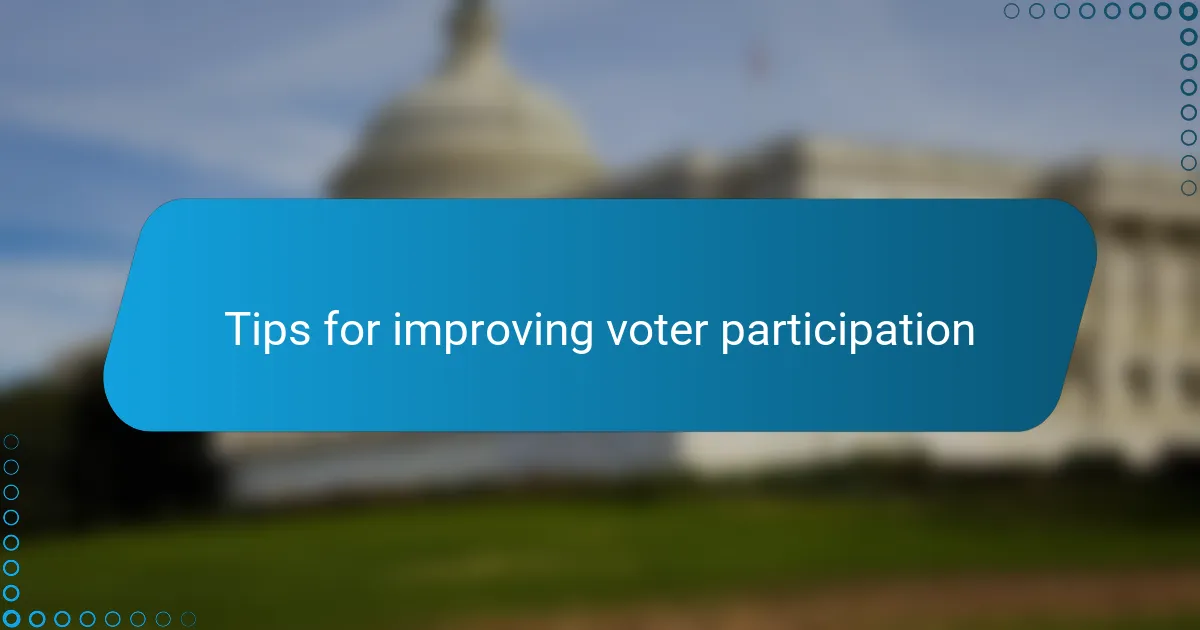
Tips for improving voter participation
When I think about boosting voter participation, making the process feel welcoming and straightforward is key. Have you ever noticed how a simple reminder—like a friendly text or a personalized call—can nudge someone who was on the fence about voting? Small gestures like these often spark that crucial final step from intention to action.
Another tip I find effective is tapping into community networks. I’ve seen firsthand how local leaders or trusted neighbors rally others by sharing why voting matters to them personally. Doesn’t it seem that when the message comes from someone relatable, it resonates on a deeper level than any generic campaign ad?
Lastly, I can’t overstate the power of timing and messaging that connects emotionally. When people feel the stakes are tied to their daily lives—whether it’s education, healthcare, or safety—they’re much more likely to prioritize voting. From my experience, asking questions that invite reflection, like “What kind of future do you want for your family?” opens the door to genuine engagement and ultimately higher turnout.
